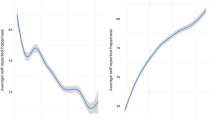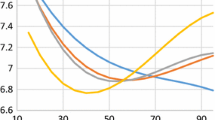Abstract
The paper retests the U-shaped relationship between happiness and age using the cross-classified multilevel regression procedure and the World Values Survey data. The analysis accounts for period and cohort effects. The results reconfirm the pattern that happiness is U-shaped in the life course. That is, happiness decreases from a high-point in young adulthood, reaches a low-point in midlife, and thereafter increases to arrive at another high-point in old age. The results show that the high-point of happiness in old age is lower than the high-point of happiness in young adulthood. That happiness does not return to its initial high-point after it drops to a low-point in midlife is perhaps another stylized fact in the relationship between happiness and age.

Similar content being viewed by others
Notes
The literature says that happiness exhibits good validity and reliability properties. For validity, studies find a high correlation between the personal appraisal about happiness and, say, success in careers (Diener et al. 2002) or in other life domains like family life (Lyubomirsky et al. 2005), engagement in their society (Guven 2011), good health (Weinman et al. 2008), longevity (Danner et al. 2001), or smiling (Ekman et al. 1990). There is also a high correlation between the personal appraisal about happiness and the appraisal of spouse, relatives, and friends (Costa and McCrae 1988; Sandvik et al. 1993). For reliability, studies find that the reports about happiness at different points in time are stable and consistent as long as no extraordinary life events occur between periods (Andrews and Withey 1976; Diener and Larsen 1984; Costa and McCrae 1988; Ehrhardt et al. 2000; Schimmack and Oishi 2005). Thus, all things the same, a person who is happy at time t is also happy at time t + 1.
I use both period and cohort to determine the age of a person or both period and age to determine the cohort of a person whenever the information is missing in the raw data. I exclude entries that do not report information for age and birth year.
The "Appendix" contains the results of a regression analysis using a 2-level multilevel regression procedure.
Grouping countries into “Western and rich countries” and “other countries” lead to the same conclusion as well. Details are available from the author.
References
Andrews, F.: Objective social indicators, subjective social indicators, and social account systems. In: Juster, F., Land, K. (eds.) Social Accounting Systems, pp. 377–419. Academic Press, New York (1981)
Andrews, F., Withey, S.: Social Indicators of Well-Being. Plenum Press, New York (1976)
Argyle, M.: The Psychology of Happiness. Routledge, London (2001)
Belk, R.: Materialism: trait aspects of living in the material world. J. Consum. Res. 12(3), 265–280 (1985)
Bell, A.: Life course and cohort trajectories of mental health in the UK, 1991–2008—a multilevel age-period-cohort analysis. Soc. Sci. Med. 120(November), 21–30 (2014)
Blanchflower, D.: International evidence of well-being. In: Krueger, A. (ed.) Measuring the Subjective Well-Being of Nations, pp. 155–226. University of Chicago Press, Chicago (2010)
Blanchflower, D., Oswald, A.: Is well-being U-shaped over the life-cycle? Soc. Sci. Med. 66(April), 1733–1749 (2008)
Brassen, S., Gamer, M., Peters, J., Gluth, S., Büchel, C.: Don’t look back in anger! Responsiveness to missed chances in successful and nonsuccessful aging. Science 336(6081), 612–614 (2012)
Brown, S., Durand, R., Harris, M., Weterings, T.: Modelling financial satisfaction across life stages: a latent class approach. J. Econ. Psychol. 45(December), 117–127 (2014)
Campbell, A., Converse, P., Rodgers, W.: The Quality of American Life: Perceptions, Evaluations, and Satisfaction. Russell Sage Foundation, New York (1976)
Carstensen, L.: Evidence for a life-span theory of socioemotional selectivity. Curr. Dir. Psychol. Sci. 4(5), 151–155 (1995)
Cheng, T., Powdthavee, N., Oswald, A.: Longitudinal evidence for the midlife nadir in human well-being: results from four data sets. Econ. J. 127(599), 126–142 (2017)
Clark, A.: Unemployment as a social norm: psychological evidence from panel data. J. Labor Econ. 21(2), 323–351 (2003)
Clark and Oswald: Unhappiness and unemployment. Econ. J. 104(424), 648–659 (1994)
Costa, P., McCrae, R.: Personality in adulthood: a 6-year longitudinal study of self-reports and spouse ratings on the NEO personality inventory. J. Pers. Soc. Psychol. 54(4), 853–863 (1988)
Danner, D., Snowdon, D., Friesen, W.: Positive emotions in early life and longevity: findings from the nun study. J. Pers. Soc. Psychol. 80(5), 804–813 (2001)
de Ree, J., Alessie, R.: Life satisfaction and age: dealing with under identification in age-period-cohort models. Soc. Sci. Med. 73(July), 177–182 (2011)
Deaton, A.: Panel data from time series of cross-sections. J. Econom. 30(1–2), 109–126 (1985)
Diener, E., Larsen, R.: Temporal stability and cross-situational consistency of affective, behavioral, and cognitive responses. J. Pers. Soc. Psychol. 47(4), 580–592 (1984)
Diener, E., Suh, E., Lucas, R., Smith, H.: Subjective well-being: three decades of progress. Psychol. Bull. 125(2), 276–302 (1999)
Diener, E., Nickerson, C., Lucas, R., Sandvik, E.: Dispositional affect and job outcomes. Soc. Indic. Res. 59(3), 229–259 (2002)
Easterlin, R.: Does economic growth improve the human lot? Some empirical evidence. In: David, P., Reder, M. (eds.) Nations and Households in Economic Growth: Essays in Honor of Moses Abramovitz, pp. 89–125. Academic Press, New York (1974)
Easterlin, R.: Happiness and economic growth: The evidence. In: Glatzer, W., Camfeld, L., Moller, V., Rojas, M. (eds.) Global Handbook of Quality of Life, pp. 283–299. Springer, Heidelberg (2015)
Easterlin, R.: “Paradise lost?,” IZA Discussion Paper No. 9676. Institute for the Study of Labor, Bonn (2016)
Easterlin, R., Schaeffer, C.: Income and subjective well-being over the life cycle. In: Ryff, C., Marshall, V. (eds.) The Self and Society in Aging Processes, pp. 279–301. Springer, New York (1999)
Ekman, P., Davidson, R., Friesen, W.: The Duchenne smile: emotional expression and brain physiology II. J. Pers. Soc. Psychol. 58(2), 342–353 (1990)
Ehrhardt, J., Saris, W., Veenhoven, R.: Stability of life satisfaction over time: analysis of change in ranks in a national population. J. Happiness Stud. 1(2), 177–205 (2000)
Frijters, P., Beatton, T.: The mystery of the U-shaped relationship between happiness an age. J. Econ. Behav. Organ. 82(May), 525–542 (2012)
Glenn, N.: Distinguishing age, period, and cohort effects. In: Mortimer, J., Shanahan, M. (eds.) Handbook of the Life Course, pp. 465–476. Springer, New York (2003)
Glenn, N.: Is the apparent U-shape of well-being over the life course a result of inappropriate use of control variables? A commentary on Blanchflower and Oswald (66: 8, 2008, 1733–1749). Soc. Sci. Med. 69(August), 481–485 (2009)
Guven, C.: Are happier people better citizens? Kyklos 64(2), 178–192 (2011)
Inglehart, R., Foa, R., Peterson, C., Welzel, C.: Development, freedom, and rising happiness. Perspect. Psychol. Sci. 3(4), 264–285 (2008)
Lawton, M.: Quality of life and affect in later life. In: Magai, C., McFadden, S. (eds.) Handbook of Emotions, Adult Development and Aging, pp. 327–348. Academic Press, San Diego (1996)
Lyubomirsky, S., King, L., Diener, E.: The benefits of frequent positive affect: does happiness lead to success. Psychol. Bull. 131(6), 803–855 (2005)
Mason, R., Faulkenberry, G.: Aspirations, achievements, and life satisfaction. Soc. Indic. Res. 5(2), 133–150 (1978)
Mason, W., Fienberg, S.: Cohort Analysis in Social Research: Beyond the Identification Problem. Springer, New York (1985)
McAdams, K., Lucas, R., Donnellan, B.: The role of domain satisfaction in explaining the paradoxical association between life satisfaction and age. Soc. Indic. Res. 109(2), 295–303 (2012)
McMahon, E., Estes, D.: Age-related differences in lay conceptions of well-being and experienced well-being. J. Happiness Stud. 13(1), 79–101 (2012)
Michalos, A.: Multiple discrepancies theory (MDT). Soc. Indic. Res. 16(4), 347–413 (1985)
Mogilner, C., Kamvar, S., Aaker, J.: The shifting meaning of happiness. Soc. Psychol. Pers. Sci. 2(4), 395–402 (2011)
Oishi, S., Graham, J., Kesebir, S., Galinha, I.: Concepts of happiness across time and cultures. Pers. Soc. Psychol. Bull. 39(5), 559–577 (2013)
Plagnol, A.: Financial satisfaction over the life course: the influences of assets and liabilities. J. Econ. Psychol. 32(1), 45–64 (2011)
Ryff, C.: Psychological well-being in adult life. Curr. Dir. Psychol. Sci. 4(4), 99–104 (1995)
Sandvik, E., Diener, E., Seidlitz, L.: Subjective well-being: the convergence and stability of self-report and non-self-report measures. J. Pers. 61(3), 317–342 (1993)
Schimmack, U., Oishi, S.: The influence of chronically and temporarily accessible information on life satisfaction judgments. J. Pers. Soc. Psychol. 89(3), 395–406 (2005)
Schwandt, H.: Unmet aspirations as an explanation for the age U-shape in wellbeing. J. Econ. Behav. Organ. 122(February), 75–87 (2016)
Steptoe, A., Deaton, A., Stone, A.: Subjective wellbeing, health, and ageing. Lancet 385(9968), 640–648 (2015)
Stone, A., Schwartz, J., Broderick, J., Deaton, A.: A snapshot of the age distribution of psychological well-being in the United States. Proc. Natl. Acad. Sci. 107(22), 9985–9990 (2010)
Van Landeghem, B.: A test for the convexity of human well-being over the life cycle: longitudinal evidence from a 20-year panel. J. Econ. Behav. Organ. 81(February), 571–582 (2012)
Weinman, J., Ebrecht, M., Scott, S., Walburn, J., Dyson, M.: Enhanced wound healing after emotional disclosure intervention. Br. J. Health Psychol. 13(1), 95–102 (2008)
Wunder, C., Wiencierz, A., Schwarze, J., Küchenhoff, H.: Well-being over the life span: semiparametric evidence from British and German longitudinal data. Rev. Econ. Stat. 95(1), 154–167 (2013)
Yang, Y.: Social inequalities in happiness in the United States, 1972–2004: an age-period-cohort analysis. Am. Sociol. Rev. 73(2), 204–226 (2008)
Yang, Y., Land, K.: Age-Period-Cohort Analysis. CRC Press, Boca Raton (2013)
Funding
This study was funded by a research grant from Ateneo de Manila University (Grant Number: RCW-18-2016).
Author information
Authors and Affiliations
Corresponding author
Ethics declarations
Conflict of interest
The author declares no conflict of interest.
Ethical approval
This article does not contain any studies with human participants or animals performed by any of the authors.
Appendix
Appendix
The results in Table 3 below are comparable to the results in Table 1 in the main text: happiness is U-shaped with age and its low-point is in the mid-40s. Like Table 1 in the main text, Models I to IV in Table 3 below indicate large variations at the country level. Like in the main text, the estimate for the coefficient of GDP per capita is consistent with the Easterlin Paradox (Model III); and there is a norm effect in happiness (Model IV).
A more important point from Table 3 is the following: the results of a 2-level multilevel specification are also useful for analyses of the relationship between happiness and age. Put differently, the results of analyses that do not focus on age, cohort, and period need not obtain misleading estimates.
Rights and permissions
About this article
Cite this article
Beja, E.L. The U-shaped relationship between happiness and age: evidence using world values survey data. Qual Quant 52, 1817–1829 (2018). https://doi.org/10.1007/s11135-017-0570-z
Published:
Issue Date:
DOI: https://doi.org/10.1007/s11135-017-0570-z




